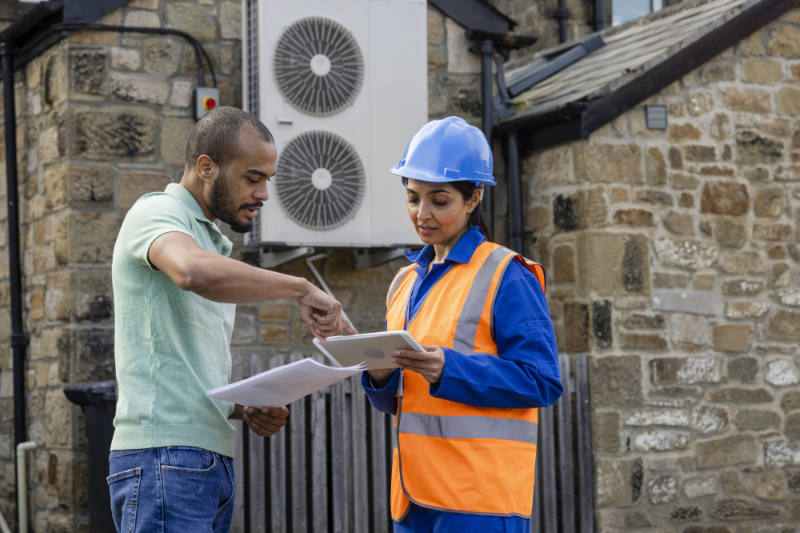What Is a Heat Pump?

Imagine if your air conditioner and furnace teamed up into one super-efficient system—kind of like a superhero duo for your home comfort. That’s basically what a heat pump is. It’s one unit that can heat your home in the winter and cool it in the summer, all while using less energy than traditional systems.
In fact, according to the US Department of Energy (DOE), air-source heat pumps use up to 50 percent less energy than furnaces or baseboard heaters—and water and geothermal models are even more efficient than their air-sourced counterparts.
But how do heat pumps even work? And why is everyone suddenly talking about them? Whether you’re trying to cut your utility bills, reduce your carbon footprint, or just understand your options before replacing old HVAC equipment, this blog breaks it down in simple terms.
Maki Heating & Air Conditioning is pleased to bring the finest HVAC options to Auburn, and surrounding area residents. Let’s take a closer look at what makes heat pumps so cool (and warm!).
Heat Pump Types and How They Work
There are three basic categories of heat pumps:
Air Source Heat Pumps (ASHPs)
Air source heat pumps are the most common and popular option. They harness heat energy in the air, transferring it from the outdoors to indoors on a cold day, or removing the heat from your home on a warm day. ASHPs have a compressor, an indoor coil, and an outdoor coil. The coils pump refrigerant, a substance that can absorb heat and release it. The indoor coil is also called a heat exchanger.
Older or lower-end heat pumps don’t fare as well in subfreezing temperatures—you’ll want a cold climate heat pump for that! However, you can pair them with a furnace programmed to kick on when the temperature dips below 30 degrees Fahrenheit. This combination, known as a dual-fuel system, lets you enjoy the heat pump’s efficiency benefits without the risk of losing heat. Additionally, newer and more advanced heat pumps are hitting the market that can handle cold winters.
Water Source Heat Pumps (WSHPs)
Water source heat pumps operate much like ASHPs—except they harness heat from a body of water instead of the air. For homeowners living near ponds, lakes, wells, or other water sources, a WSHP can be the perfect match. A series of underwater pipes cycle liquid, collecting heat. The heat gets picked up by the heat exchanger, which transfers it to your home via ductwork. On hot days, the process works in reverse to provide air conditioning.
While they cost more upfront, WSHPs use a fraction of the energy that the already-efficient ASHPs use. You’ll see considerable monthly savings and significantly reduce your carbon footprint.
Geothermal Heat Pumps (GHPs)
Ground source heat pumps, or geothermal systems, use pipes with liquid to collect heat like WSHPs, but the pipes are underground instead of underwater. The Earth has relatively consistent underground temperatures, ranging from 45 to 75 degrees, depending on latitude. This constant temperature makes it a reliable source for heating.
GHPs have pipe systems buried four or more feet underground. The pipe system can run horizontally or vertically, depending on what you and your Maki Heating & Air Conditioning specialist determine works best with your California property. Like other heat pump models, the heat gets transferred to the heat exchanger and distributed through your ducts with an air handler.
GHPs are among the most efficient heating sources on the planet. Like WSHPs, they cost more upfront but pay off significantly with long-term savings. Although heat pumps use electricity, carbon emissions can be cut to nearly zero when you pair them with a solar panel. Many owners also pair them with a ductless mini split, another great option to increase efficiency.
Heat Pump Maintenance and Upkeep
Heat pumps provide heating and cooling capabilities—there’s no need to supplement your heat pump with an air conditioner. That means you only have one system to worry about for repairs and maintenance costs!
The DOE recommends an annual maintenance visit to keep your heat pump system is operating at its best. One of our Maki Heating & Air Conditioning specialists will check for leaky ductwork, which can lead to energy loss. They will also inspect refrigerant levels. Refrigerant leaks can harm your indoor air quality (IAQ) and impair the functionality of your heat pump.
Schedule HVAC Service With Your Auburn, Expert Today!
We’re pleased to offer our unmatched heating and cooling expertise to our neighbors in Auburn, CA. For reliable, efficient, and friendly home service, call Maki Heating & Air Conditioning at 530-885-3449 today, or set up your visit online.
